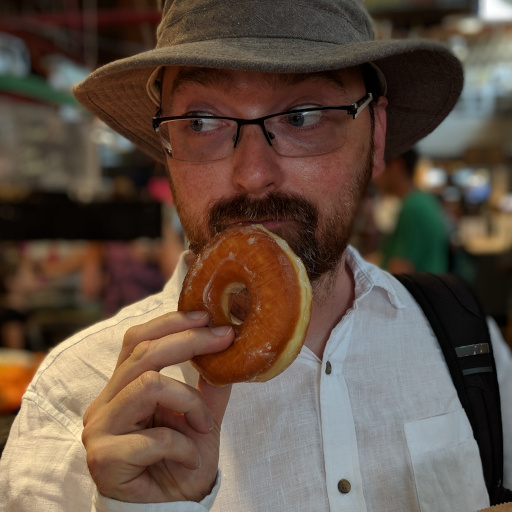I really like gnome and how it looks. However every time I try it I find myself in need of more functionality and so I install a bunch of extensions. For example I can’t live without a dock and some sort of system tray that shows which apps are running in background.
Sometimes the extensions have small UI inconsistencies or use more memory than usual. That’s why I totally ditched gnome and switch to KDE.
Also I tend to think it’s been designed for people who are more comfortable using a keyboard. I’m mostly a mouse person.
Do any of you run pure gnome with no extensions? How do you cope with the lack of a dock and system tray?
You’re trying to use Gnome the way you’re used to using a desktop.
If you try and learn the Gnome way, you’ll have a better time.
To be honest I had the same problem when I first went from Windows to OSX, I was struggling, trying to make OSX familiar, but when I decided to learn the Apple way, everything became easier.
My problem is that I feel gnome is geared toward a certain group of people users who use a limited set of apps and want to focus on development work.
Well I think that’s the issue here. It’s not geared towards a group of people, but towards an ideal workflow which is the Gnome Way.
If you’re someone that likes to have masses of applications or windows open you can certainly use Gnome, but the Gnome is more focused on one or two windows per desktop/workspace and I encourage you to embrace that way of working too
Again, it’s not about people, but the intended user experience.
I remember when Windows first introduced My Documents folder and subfolders for images, music, video. To begin with I rejected this folder because I wanted my folders in the root C: as I had always done. Eventually I decided to use these folders and I learned to appreciate the convenience of this, including all the additional thumbnails and meta data that the OS provided automatically for those folders.
deleted by creator
deleted by creator
Have you considered Pop OS from System76? Pop OS has a GNOME-like DE where the dock is fully displayed. It’s very much like the macOS DE. The current stable release uses a GNOME-like DE, and the developers at System76 are working to make it into their own DE called Cosmic.
Thanks, yeah I’ve heard good things about Cosmic. I’ll give it a try when it’s available on Fedora.
I have extensions that do small QOL things. I can still use GNOME just fine without a single one of them enabled.
How do you cope with the lack of a dock and system tray?
I don’t cope with that. I don’t really see a huge benefit to having a system tray. Before GNOME 44 added the background apps view to the quick settings menu I just put anything that was ‘background’ into a workspace. Even after 44 I still have this habit and rarely actually need the background view.
As for the dock argument I’m not sure what an always visible dock would provide that the current dash does not. I think I might even prefer the current dash over an always visible dock. Whenever I want to switch windows I just go to the overview and pick out whatever window I want. It’s a lot easier to hit a huge window than to have to target a small icon at the bottom of the display.
I understand that some people might disagree but I actually love what GNOME does (most of the time).
How do you tell when you’ve got mail, or someone messaged you?
Notifications?
And if I wasn’t there for the notification?
The thought of not being able to tell how many apps are running at a glance is unsettling for me.
Body
Cancel Preview Save
I use it with a system tray but no dock. The overview when you press meta is enough for me.
I tried really hard for about a year to use gnome without extensions.
I’d say at best in the end it wasn’t annoying me too much.
Recently tried dash to panel again and yeah. I’m not going back.
I do not understand how people manage multiple programs open without a tray. Do they just memorize in what workspace everything is at all times ?
I found it preferable when I started exclusively using the keyboard and keybinds. Tho I ended up using a TWM so I’m definitely not the target audience lol.
That’s me!
Keyboard centricity is a bonus to me. I don’t like having visible UI elements that don’t do anything for me (docks, task bars). I also dislike the trend of programs not closing when I close them (system trays).
In addition to these things, I value a degree of minimalism, and I’m a heavy user of virtual desktops.
I don’t need to cope with any of these potential downsides, as they’re not downsides to me in the first place. All of this said, the KDE community seems a lot more welcoming. I tend to suggest KDE Plasma for any people trying out Linux.
Hope this helps 👍
EDIT: I almost forgot to mention the most controversial one of them all. I love single click to open.
For your last sentence, single click can prevent things like carpal tunnel, but at the same time that’s undoing decades of habit.
I use Debian + Gnome without custom extensions and like it.
I don’t use too many programs, so in the overview I have Firefox in position 1, signal in position 2 and steam in 3. Then I use Win+1,2,3 to launch them.
For other programs, I hit Win and then start typing the name and hit enter.
For switching between windows, i use alt-tab or alt-(key above tab). If I have many windows or playing game in full screen, I hit Win-key once and choose the window i want.
I don’t use workspaces, never found a good flow. And I rarely miss a taskbar.
I use blur my shell, but I don’t really need it.
I started liking Gnome a lot more once I let go of trying to recreate the Win95 UX that pretty much everyone else uses.
It was such a pain at first, but then it just clicked and now I couldn’t go back to that clunky workflow.
I know most people like it that way, but IMO Microsoft didn’t create the perfect UX paradigm back in the early 90s
I agree. I prefer a windows 7 like Superbar more.
Please XFCE, stop wasting my dock space. I use KDE solely because I couldn’t get a normal taskbar on XFCE.
How long did it take for it to click for you? I tried for about a year and it never did to me.
I ended up quite fast at it but it never became natural.
It took a couple of weeks of irritation
So maybe it’s just not for everyone! Good thing we have plenty of options
deleted by creator
I don’t use the dock or a system tray really.
- Each app is opened on its own workspace and it’s always the same workspace. Slack on 1, Thunderbird on 2, Tilix on 3, IDE on 4, Firefox on 5, etc.
- Each workspace gets its own key mapping:
Ctrl+F1for 1,Ctrl+F5for 5, etc. so switching is quick and easy with no mouse needed. - To open a new program I just hit
Winfollowed by the first 2 or 3 letters of the name andEnter.
I use the following extensions:
- Burn My Windows
- Pure Perfection
- Clipboard indicator (for clip history)
- System Monitor (to keep an eye on resource use)
I might try this workspace malarkey. Sounds like a nice flow
Yeah pure gnome would be great if they:
- provided desktop icons (like they used to);
- had an option to disable the activity BS on startup and go straight to the desktop.
But oh well, the GNOME team is more occupied with censoring comments on their blog and trying to re-invent the desktop environment experience with animations and whatnot instead of focusing on what really delivers productivity.
Both of those would, to me, seem like negatives.
Desktop icons have no benefit for me and would look ugly. Opening in the desktop would mean that I would have to press super before launching all my apps, which would be annoying.
Since GNOME disabled desktop icons years ago, I liked it so much that I disable them in every OS I use, even on Windows.
They are just ugly and make the whole system feel messy. I do t need that. I can use the search or a favourites thing in a hidden drawer like the start menu or the gnome dock.
I spent the past three months with desktop icons and disabled them two days ago when I realized I was almost never using them.
Why can’t we just have toggles under settings (like we did in the past for desktop icons), works for you, works for me. Everyone will be happy.
Because it takes manpower to develop and maintain these features?
Especially desktop icons are difficult to get right (see workarounds like “ReIcon” on Windows). E. g. keeping icon positions across multiple monitors and varying resolutions and displays (which can be unplugged at any time). They can also be a privacy-issue, e. g. when doing a presentation.
But most importantly: GNOME doesn’t want to be a traditional (Windows-like) desktop, so why would they implement features that don’t align with their ideas for a desktop experience?
There are lots of other desktops, like Cinnamon, that offer a traditional desktop experience within the GTK ecosystem. There is also plenty of room for desktops, like GNOME, that have a different philosophy and feature set.
In my opinion it would be boring, if every desktop tried to do the same thing. And there wouldn’t be any innovation, if no one tried to do things differently.
Especially desktop icons are difficult to get right
This doesn’t just affect desktop icons, icons in general suck under Linux. Things have strange behaviors when selected, long names don’t work properly etc.
But most importantly: GNOME doesn’t want to be a traditional (Windows-like) desktop, so why would they implement features that don’t align with their ideas for a desktop experience?
Because GNOME is the only DE with some potential and by not having 2 or 3 simple optional features aren’t getting more traction. I bet half of the KDE users would be glad to use GNOME only if it had desktop icons. Using other DE doesn’t make much sense as you’ll inevitable run in GTK and parts of GNOME and having to mix and match to get a working desktop experience.
Again, GNOME had icons, v3.28 discontinued them for no other purpose than trying to re-inveting something that worked for a ton of people.
Because GNOME is the only DE with some potential and by not having 2 or 3 simple optional features aren’t getting more traction.
But everyone has different requirements and my “2 or 3 simple optional features” that are missing are completely different than what you think is missing. I couldn’t care less about desktop icons or system trays. I even prefer not having a system tray, as this functionality should be provided via notifications and regular application shortcuts in my opinion.
But in the end, a software project only has a limited amount of resources available and developers have to decide where they want to focus on. GNOME chose not to focus on desktop icons:
GNOME had icons, v3.28 discontinued them
Because the code was “old and unmaintained” and probably no one was willing to modernise and maintain it. Desktop icons were already disabled by default before 3.28, so they didn’t “re-invent” this feature with the removal of the code in Nautilus.
Using other DE doesn’t make much sense as you’ll inevitable run in GTK and parts of GNOME and having to mix and match to get a working desktop experience.
I use GNOME and KDE and use the same applications (as Flatpaks) on both desktops: I use GNOME Calculator on KDE, because I dislike both KDE calculators, and I use Ark on GNOME with a Nautilus script, as File Roller doesn’t allow me to set the compression ratio (I need to create zip files with 0 compression for modding games). So for me it has become the norm to mix applications created with different toolkits. Thanks to Flatpak I still have a “clean” base system though.
Btw. I am getting tired of these re-occurring complaints that GNOME works differently than other desktops. I am not constantly complaining about what features KDE is, in my opinion, missing all the time either (e. g. dynamic workspaces, same wallpaper and desktop configuration across all existing and new monitors, online account integration, command line config tool, etc.), instead I accept that this is how it is at the moment and either use KDE the way it is (like I do on my desktop PC) or use something that better suits my needs (like I do on all my laptops).
Innovation or regression? Gnome used to have optional desktop icons. They removed them. Let’s settle on gnome is progressing, while keeping in mind, that progress is neither necessarily nor inherently good.
Innovation or regression?
Innovation doesn’t necessarily mean that all past functionality needs to be carried over. Actually innovation often means that past technology becomes obsolete and gets replaced with something new.
Gnome used to have optional desktop icons. They removed them.
They removed them because with GNOME Shell those icons no longer made sense. There was no longer a concept of dragging apps from a panel menu to a desktop, instead apps were now pinned from the fullscreen app overview to the dash.
Since the code was no longer used by the default GNOME experience, it became unmaintained and eventually got removed.
you’re using it wrong. ™
activity should be treated as the “default” mode of gnome (also you need to go to it do launch anything anyway)
also desktop icons sucklol
I get understand wanting desktop icons even though I don’t like them personally, but what’s the advantage of starting at the desktop instead of the overview? It seems like you would probably want to open an application when you log in so it seems more convenient to already be in the overview
Not having a dock is one of my favorite things about gnome. I actually use an extension to hide the top bar too. There’s just something so satisfying about having 100% usable space on screen. I get all the info back in the win-key overlay, so I don’t really need that stuff on screen at all times.
win-key overlay
explain please
When you hit the windows key (aka meta-key or super-key) it brings up the app launcher. You get a dock at the bottom with pinned or running apps (like a taskbar), and all of your open windows are presented in a sort of mini-version that lets you switch between them or move them between workspaces. There is a search bar that you can immediately type into to open any app with a .desktop file. There is also a button to bring up the app grid which shows your apps kind of like a mobile device’s home screen.
That’s what you meant with overlay!
I was confused because an Overlay is something like a Tooltip.
I personally would call this an Overview
Anyways, thanks for your answer! :)
I do. I miss the system tray, to be honest. My way to deal with it is to just push applications I need running all the time to the last workspace and leave this alone. Sometimes I close them unintendedly, oh well…
Dash to dock. I just have to. I put it on the left Ubuntu style and I’m happy













